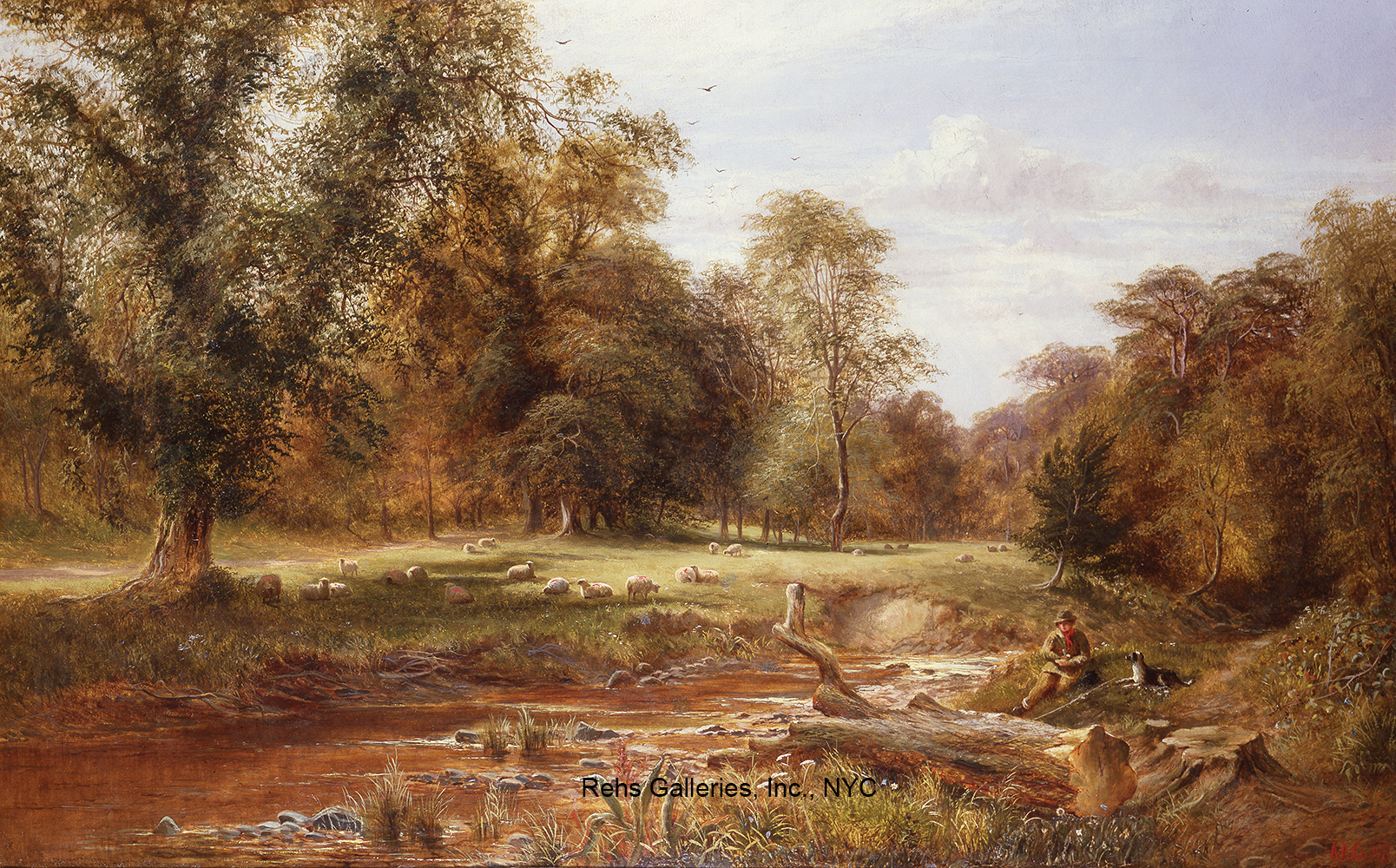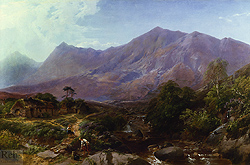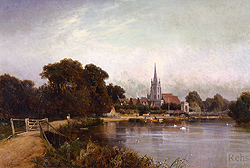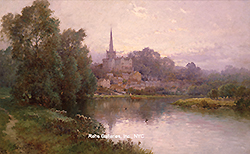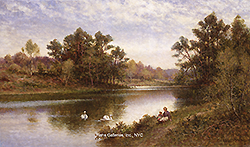Victorian Landscape Art 1
The following exhibition is a tour through the English countryside during the 19th & early 20th centuries, as seen through the eyes of some of Britain's most famous Victorian landscape artists. With the Industrial Revolution in full swing, England's cities were growing at an alarming rate. The new Bourgeoisie became wealthier and wealthier while the class of people they exploited lived in horrid conditions - and all lived in these expanding, overcrowded cities.
The nouveau riche, like those before them, turned some of their interests towards the patronage of the arts. Many of these city dwellers were born and raised in the countryside, and after living in crowded cities, they longed for a taste of a quieter and simpler time. With the development and expansion of the railway system, artists were able to travel greater distances in search of suitable subject matter, and their patrons were eager to acquire their idyllic views.
Depictions of a 'rural paradise' were, for a large part, pure fiction. Life in the countryside was rough, and the condition in which the people lived was far from pleasant or comfortable. However, very few of the artists displayed life as it was. Instead, they glorified the beauty of England's countryside and portrayed its residents as happy and content - children playing, workers resting, men fishing, lovers conversing.
Among the most popular artists of the period, and featured in this virtual exhibition, were Henry John Boddington, Sidney Richard Percy, Edward Charles Williams, Henry Jutsum, Benjamin Williams Leader, William Gosling, Alfred De Breanski, Henry H. Parker, Alfred A. Glendening, and Albert Goodwin. While styles and techniques changed throughout the period - with the earlier artists adhering to the teachings of the Dutch masters and the latter incorporating changes brought about by the Impressionists - their subject remained the same, the British landscape.
E.C. Williams, S.R. Percy, and H.J. Boddington were all members of the famed Williams family of artists - a branch of the Ward family - which produced more than 15 artists during the period. Edward C. Williams (1807-1881) was the eldest son of Edward Williams. A student of his father, his style and technique remained close to that of his master. Like the other members of his family, he specialized in landscapes. His favorite time of day to portray was morning, often capturing the sun's effects in extensive, open, tranquil views in Barnes, Cumberland, Kent, Surrey, and along the Thames.
Henry J. Boddington (1811-1865), born Henry J. Williams, was the second son to Edward Williams (Henry married Clarissa E. Boddington in 1832 and took her maiden name to separate his work from that of his brothers). Henry displayed an early talent for painting and received his only formal training from his father. He quickly developed an individual style - characterized by his manipulation of blocked light as it filtered through an archway of trees. Jan Reynolds notes in her book The Williams Family of Painters that one of Boddington's ".... most characteristic effects is the appearance of a warm day, with the sun just out of the picture, giving a filmy, hazy atmosphere to the landscape, with deep blue shadows adding greater value to the opposing tone of yellow. The distant mountains are melting in vapory sunlight. The artist is a master of this effect..." Like many of his contemporaries, he loved to work on a grand scale. The Fine Arts Quarterly Review (Vol. 3, 1865) noted that he was "...an artist who, if he fell into mannerism, had yet during a hard-working life, painted pictures not only large, but sometimes grand. His landscapes of mountains, lake, and river had scenic breadth and power..."
Sidney Richard Percy (1821 - 1886) was Edward Williams's fifth son, and like some of his brothers, he changed his last name to distinguish his work from the other family members. Percy was born in London and began his career after his elder brothers were already established. His style owes much to his brother H.J. Boddington, however, his technique and coloration were all his own. Percy's deepest attachment was to the scenery of Wales, and he enjoyed walking off into remote areas in the mountains and paint. Jan Reynolds writes in her book The Williams Family of Painters that "...a clean fluency of manipulation is the hallmark of the Percy technique, in which the brushwork indicates form, with a very smoothly controlled line. I was remarked that his rocks and stones were sufficiently accurate to have served as illustration to the writings of Sir Frederick Murchison, the popular 19th century geologist."
Another artist, working in a similar style to the Williams family, was Henry Jutsum. Born in London in 1816, his life paralleled that of both Boddington and Percy and, for a time, was a student of the Norwich School artist James Stark (1794-1859). During the early part of his career, Jutsum favored painting with watercolors - becoming a member of the New Watercolor Society in 1843. However, by 1848 he was working primarily in oil paints and resigned his membership in the Society. Jutsum's style was crisp and clean, capturing the majesty of England's mountains with exacting detail. His similarity, in both subject matter and coloration, to the works of H.J. Boddington and S.R. Percy is superbly illustrated in the works featured here.
As the Victorian Era progressed, the influence in style and techniques of artists from other countries became more evident in the work of the British landscape painters - one of the most important being the French Impressionists.
William W. Gosling (1824-1883) continued in the traditions of the 'pure' landscape into the latter half of the century and was one of the early artists to exhibit the Impressionist's influence. While his subject matter was similar to that of the Williams family, his palette was lighter, and his brushwork was a bit looser. The Art Journal, 1873, commented on the work he exhibited at Suffolk Street that year: "By William Gosling is a landscape of remarkable power... It is entitled Harvet Time at Hennerton... and shows a field of corn already yielding to sickle. The expanse of golden grain is bounded by dense wood; and altogether the work is so much superior to others that have proceeded it, that this artist must be estimated among those who have greatly advanced." The work illustrated here was painted four years later and has many similar qualities.
Benjamin Williams Leader (1831-1923) was another artist who, early on, picked up on the teachings of the Impressionists and melded them into a style all his own. Born Benjamin Williams, he added the name Leader later in his life so as not to be confused with the Williams family of painters (to whom he was no relation). Benjamin was the son of E. Leader Williams, a civil engineer and part-time artist, and would accompany his father on his weekend outings to paint from nature. While intending that his son would follow in his footsteps (civil engineering), Benjamin had other ideas - he abandoned his engineering studies and began to study art more formally. Benjamin enrolled in the evening classes at the Worcester School of Design and worked in his father's office during the days. In 1854, at the age of 23, he entered the Royal Academy Schools, and by 1857 had turned his attentions to landscape painting - it was also the year he added the surname Leader. Benjamin W. Leader was to become one of the great late Victorian landscape painters, and his influence can be seen in many of his contemporaries and followers.
Another interesting artist of the period was Albert Goodwin (1845-1932). While not strictly a landscape painter (he also favored biblical, allegorical, and imaginative subjects), those that he did rank among England's best. Goodwin received some early training under Arthur Hughes and Ford Madox Brown, exhibited his first work at the Royal Academy at the age of 15, and was a passionate student of Joseph M.W. Turner's work. Like the other Victorian landscapists, he painted scenes of Britain in an unspoiled manner, free from the harsh realities of the cities. Even his choice of titles evoked a feeling of purity and serenity; these included The Valley of Diamonds; A Sermon in the Hayfields; The Enchanted Lake; Under the Roof of the World and Pastoral Symphony, Guernsey (illustrated here).
Alfred De Breanski, Sr. (1852-1928), and his son Alfred De Breanski, Jr. (1877-1957) were London artists who became famous for their Welsh & Scottish mountain scenes and views along the Thames. Their landscapes, filled with light and color, often feature the sunlight radiating from within - creating a warm and peaceful feeling. This family continued the traditions of Victorian landscape art well into the 20th century.
Alfred A. Glendening (fl.1861-1908) was born in London and began his adult life as a railway clerk. Not much information exists to explain when and where he received his artistic interest and training, but in 1864 he exhibited his first work at The Royal Society of British Artists (RBA), Morning on Grassmore Lake. From that point on, he became a frequent exhibitor at the RBA, as well as the Royal Academy - exhibiting his first work there, A Cornfield - Kent, in 1865.
The English landscape was his specialty - depicting views of the Thames and scenes in Wales and Scotland. These works often featured small figures by the riverside or swans on the water. Light fills his paintings, filtering its way through a beautiful blue and white sky and casts soft shadows in the water. His landscapes are filled with subtle shades of color, and the water often cuts across the canvas vanishing around a turn in the background.
Alfred A. Glendening continued to exhibit in London through 1903 - showing more than 130 works in all.
The last artist to be discussed is Henry H. Parker (1858-1930), who was born in London and based there for most of his life. Parker's style of painting was very typical for the late Victorian landscape artists who strove to incorporate the new Impressionist techniques in their more traditional paintings. His landscapes and skies were created with a free but controlled application of paint while the watery areas of his work were handled in a more traditional way - using glazes to create depth and reflections. This colorful and free look was a welcome relief to the traditional Victorian landscapes of the previous decades, and this, coupled with Parker's choice of subject matter, brought him great success. It is fascinating to note that Parker was one of only a handful of artists of his caliber to never exhibit at the major exhibition halls in England during his lifetime.
Parker's favorite locales to paint were in Surrey, Kent, and Wales -- especially views on the Thames. Titles of some of his other works include The Mole, Dorking, Surrey; Nature's Mirror, on the Banks of the Thames (both illustrated here); Harvest Time on the Thames, Near Henley; Nature's Mirror, the River Wey and The River Loddon, Near Basing. The influence of Benjamin Williams Leader (1831-1923) is evident in Parker's work, and some have surmised that Parker may have studied with him. The works illustrated below are excellent examples of the artist's most desirable subject matter -- beautiful, rustic landscapes executed with impressionistic brush strokes and color.
In the end, these artists, and many of their contemporaries, accomplished their ultimate goal - to leave a visual history of the British landscape in its natural, unspoiled state.
This essay is copyrighted by Rehs Galleries, Inc. and may not be reproduced or transmitted without written permission from Rehs Galleries, Inc.
 Edward Charles Williams (1807 - 1881) An Old Roadside Inn Near Kent 29 1/8 x 49 3/16 Signed and dated 1850 SOLD Request More Info |
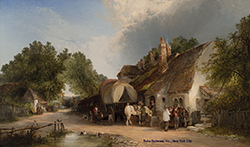 Edward Charles Williams (1807 - 1881) The Old Roadside Inn 29 1/2 x 50 inches Signed SOLD Request More Info |
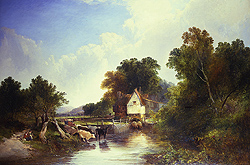 Edward Charles Williams (1807 - 1881) A Summer Evening at Sonning 40 x 61 inches Signed and dated 1859 SOLD Request More Info |
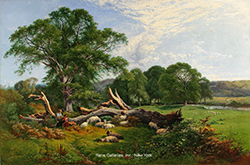 Henry John Boddington (1811 - 1865) A Summers Rest 24 x 36 inches Signed and indistinctly dated 1843 SOLD Request More Info |
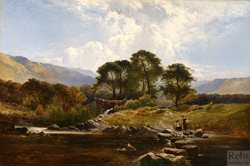 Henry John Boddington (1811 - 1865) The Way to the Mill, North Wales 24 x 36 inches Signed; also titled on a label on the reverse SOLD Request More Info |
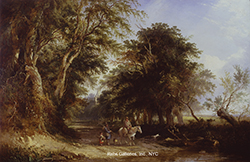 Henry John Boddington (1811 - 1865) A Wooded Lane, Otford, Kent 20 x 30 inches Signed SOLD Request More Info |
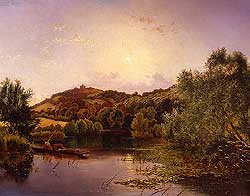 Henry John Boddington (1811 - 1865) Early Morning on the Thames 28 x 36 inches Signed SOLD Request More Info |
|
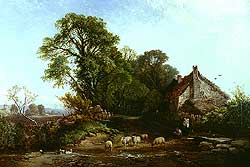 Henry John Boddington (1811 - 1865) Outside the Cottage 25 x 40 inches Signed and dated 1856 SOLD Request More Info |
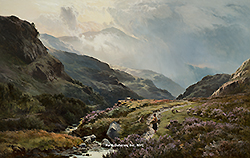 Sidney Richard Percy (1821 - 1886) Heather in the Highlands 24 x 38 inches Signed and dated 1872 SOLD Request More Info |
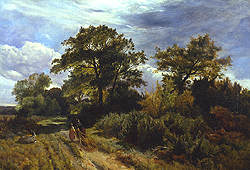 Sidney Richard Percy (1821 - 1886) Homeward Bound 16 x 23 inches Signed and dated 1851 SOLD Request More Info |
 Sidney Richard Percy (1821 - 1886) Llyn Llydaw, North Wales 15 x 23 inches Signed and dated 1872 SOLD Request More Info |
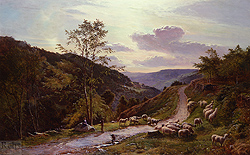 Sidney Richard Percy (1821 - 1886) Near Bettws-y-Coed 24 x 37 inches Signed and dated 1869 SOLD Request More Info |
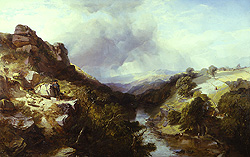 Henry Jutsum (1816 - 1869) The River Kidd, Near Knaresborough 30 x 48 inches Signed and dated 1845 SOLD Request More Info |
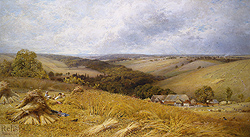 William W. Gosling (1824 - 1883) A Hot Day in the Harvest Field 33 x 63 inches Signed SOLD Request More Info |
|
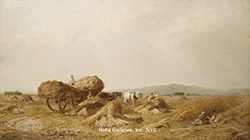 William W. Gosling (1824 - 1883) Out in the Harvest-field, A Hazy Morning "Turning-to-Heat" 34 x 60 inches Signed SOLD Request More Info |
 Benjamin Williams Leader (1831 - 1923) Evening on the Thames in Wargrave 20 x 34 1/2 inches Signed and dated 1904 SOLD Request More Info |
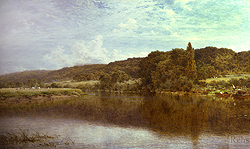 Benjamin Williams Leader (1831 - 1923) The Thames at Streatly 30 x 50 inches signed and dated 1903 SOLD Request More Info |
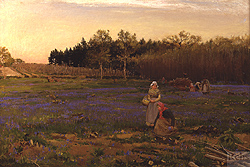 Albert Goodwin (1845 - 1932) Picking Bluebells 24 x 36 inches Signed and dated '87 SOLD Request More Info |
 Albert Goodwin (1845 - 1932) Pastoral Symphony, Guernsey 25 x 35 inches Signed and dated '92 SOLD Request More Info |
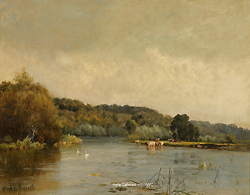 Alfred de Breanski, Sr. (1852 - 1928) An Autumn Morning, Hurley Reach 14 x 18 1/4 inches Signed; also signed and titled on the reverse SOLD Request More Info |
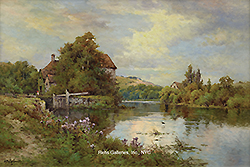 Alfred de Breanski, Jr. (1877 - 1957) Fladbury Lock on the Avon, Worcestershire 28 x 42 inches Signed; also signed and titled on the reverse SOLD Request More Info |
|
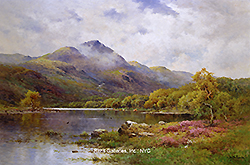 Alfred de Breanski, Jr. (1877 - 1957) The Trossachs, Ben Venue and Loch Achray 24 x 36 inches Signed; also signed and titled on the reverse SOLD Request More Info |
 Alfred de Breanski, Jr. (1877 - 1957) In the Heart of Warwickshire 32 x 24 inches Signed; also signed and titled on the reverse SOLD Request More Info |
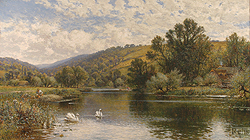 Alfred A. Glendening (Active 1861 - 1903) On the Thames 24 x 42 inches Signed and dated 1903 SOLD Request More Info |
|
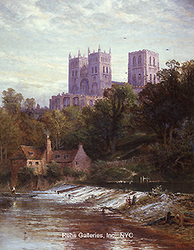 Alfred A. Glendening (Active 1861 - 1903) The Weir at Durham 36 x 28 inches Signed and dated '80 SOLD Request More Info |
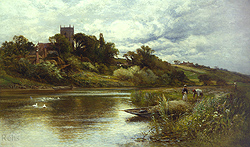 Alfred A. Glendening (Active 1861 - 1903) Belaugh on the Bure, Norfolk 30 x 50 inches Signed SOLD Request More Info |
||
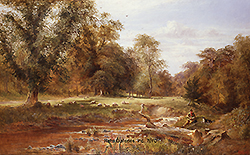 Alfred A. Glendening (Active 1861 - 1903) Summer Landscape 24 x 38 inches Signed & dated '67 SOLD Request More Info |
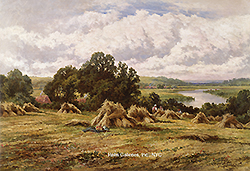 Henry H. Parker (1858 - 1930) Harvest Time on the Thames, Henley 20 x 30 inches Signed SOLD Request More Info |
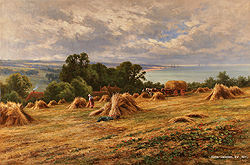 Henry H. Parker (1858 - 1930) A Sussex Cornfield, Littlehampton 24 x 36 inches Signed; also signed and titled on the reverse SOLD Request More Info |
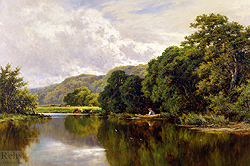 Henry H. Parker (1858 - 1930) Nature's Mirror, on the Banks of the Thames 24 x 36 inches Signed, also signed and titled on the reverse SOLD Request More Info |
 Henry H. Parker (1858 - 1930) The Mole, Dorking, Surrey 24 x 36 inches Signed, also signed and titled on the reverse SOLD Request More Info |
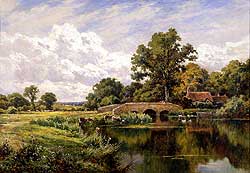 Henry H. Parker (1858 - 1930) The River Loddon, Near Basing, Hants 18 x 26 inches Signed, also signed and titled on the reverse SOLD Request More Info |

